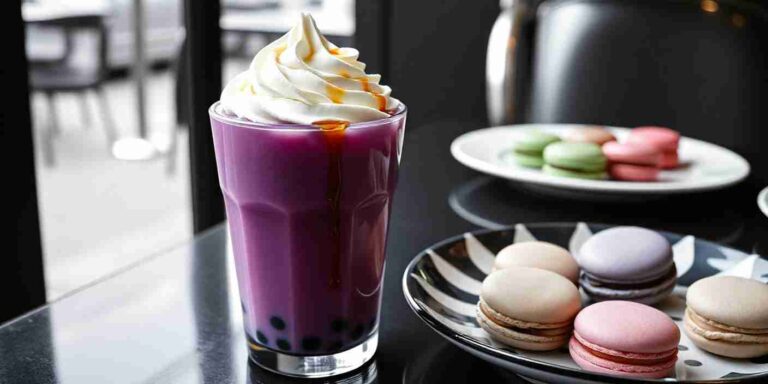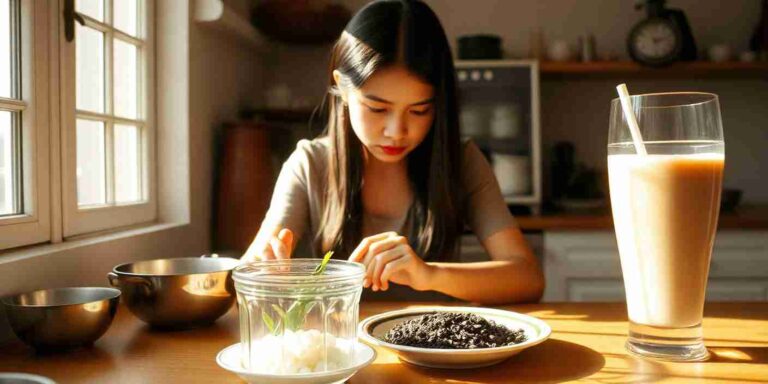How to Make Fruit Tea for Boba: A Simple Guide to Delicious Flavor Combinations!
If you want to make fruit tea for boba, you’re in for a delightful treat. This refreshing beverage combines the vibrant flavors of fresh fruit with the satisfying chewiness of tapioca pearls.
Whether you’re looking to create a fruity drink for a hot summer day or just want to enjoy something unique at home, mastering this recipe is easier than you think.
Key Takeaways
- Essential Ingredients: Gather fresh fruits like strawberries, mangoes, and kiwis, along with your choice of tea (green, black, or oolong) to create a flavorful base for your fruit tea.
- Preparation Process: Brew the selected tea according to specific instructions and allow it to cool before mixing in prepared fruits. Infuse together for at least 30 minutes for optimal flavor.
- Sweetening Options: Enhance the taste with sweeteners such as white or brown sugar, honey, or fruit syrups. Adjust sweetness based on personal preference during tasting.
- Toppings & Presentation: Add variety with toppings like tapioca pearls and fruit jellies. Use clear cups and colorful straws for an appealing presentation that showcases the vibrant colors of your drink.
- Flavor Combinations: Experiment with different fruit pairings (e.g., strawberry and kiwi) to customize flavors according to your taste preferences.
- Storage Tips: Refrigerate any leftover fruit tea quickly in an airtight container and consume within three days for the best flavor experience.
Ingredients You Will Need
To make fruit tea for boba, gather the following ingredients. Each component adds flavor and texture to your drink.
Fresh Fruits
- Strawberries: Fresh strawberries add sweetness and vibrant color.
- Oranges: Juicy oranges provide a citrusy kick.
- Lemons: Tart lemons enhance the overall flavor balance.
- Kiwi: Kiwi offers a unique taste and bright green hue.
- Red Apples: Crisp red apples contribute natural sweetness.
- Pineapple Chunks: Pineapple chunks bring a tropical flair to your tea.
- Mangoes: Ripe mangoes offer rich, sweet flavors.
- Berries: Mixed berries add freshness and antioxidants.
- Peaches: Juicy peaches infuse sweetness with a fragrant aroma.
- Lychee: Lychee gives an exotic touch and floral notes.
- Passion Fruit: Passion fruit adds tanginess with its unique scent.
- Blueberries: Blueberries provide natural sweetness and are nutritious.
Tea Varieties
Choose from these popular tea types:
- Oolong Tea: Oolong offers a smooth taste that pairs well with fruits. Steep 50g of leaves in 1 liter of boiling water at 212°F (100°C) for 12 minutes for best results.
- Green Tea (Jasmine): Green tea has light flavors that complement fruity profiles. Steep it for about 5 minutes to keep it refreshing.
- Black Tea: Black tea provides a robust base flavor that balances well with sweeter fruits.
Sweeteners and Add-Ons
Add sweetness or additional textures using these options:
- White Sugar or Brown Sugar: Both sugars dissolve easily in hot liquids while adding sweetness to your drink.
- Honey or Honey Syrup: These natural sweeteners give distinct flavor notes along with their sweetness.
- Fruit Syrup (e.g., Strawberry, Mango):
- Use fruit syrup for intense flavor bursts without extra chopping.
- Tapioca Pearls (Boba):
- Tapioca pearls create chewiness in each sip, enhancing the drinking experience.
- Ice:
- Ice keeps your boba fruit tea cool on warm days.
- Wide Straws:
- Wide straws allow you to enjoy both liquid and tapioca pearls easily.
Preparation Steps
Preparation for making fruit tea for boba involves selecting the right ingredients and ensuring they are ready to use. Follow these steps to prepare your fruit tea effectively.
Brewing the Tea
- Select Your Tea Base: Choose a high-quality tea base like green tea, black tea, or herbal tea. Green tea has antioxidants, while black tea offers a stronger flavor.
- Brew Your Tea: Steep your chosen tea according to its specific instructions:
- Brew green tea for about 3-5 minutes.
- Brew black tea for about 5-7 minutes.
Keep an eye on the time to avoid bitterness.
- Cool the Tea: After brewing, let the hot tea cool down to room temperature before mixing with fruits. Cooling prevents cooking or altering the texture of fresh fruits.
Preparing the Fruits
- Choose Your Fruit: Pick either fresh or frozen fruits such as strawberries, mangoes, or passionfruit based on your taste preference.
- Wash and Chop Fruits: Rinse all fruits thoroughly in cold water. Cut them into small pieces for better infusion and blending.
- Blend If Desired: For a smoother texture, blend chopped fruits into a puree using a blender or food processor before adding them to the brewed tea.
- Combine Ingredients: Mix cooled brewed tea with prepared fruits in a large container.
- Infuse Together: Let this mixture steep together for at least 30 minutes, allowing flavors from the fruits to enhance the taste of your fruit-infused beverage.
- Taste Test & Adjust Sweetness (Optional): After steeping, sample your drink and add sweeteners like sugar or honey if desired, adjusting sweetness levels according to personal preference.
Following these preparation steps ensures you create delicious fruit tea perfect for boba that highlights vibrant flavors and refreshing tastes.
Serving Suggestions
Serving fruit tea for boba enhances the experience and brings out the flavors. When you present your drink in a fun way, it adds to its appeal.
Boba Toppings
Add variety with different toppings. Popular options include:
- Tapioca Pearls: These chewy balls provide texture.
- Fruit Jellies: Choose from mango or lychee for added sweetness.
- Popping Boba: These burst with flavor when bitten into.
- Coconut Jelly: This topping offers a refreshing contrast.
Mix and match toppings for unique combinations that suit your taste.
Presentation Ideas
Presenting your fruit tea nicely makes it more enjoyable. Consider these ideas:
- Use clear cups to show off the vibrant colors of the tea and fruits.
- Add ice cubes made from fruit juice for an artistic touch.
- Garnish with fresh herbs like mint or basil for aroma and flavor.
- Serve with colorful straws that match the theme of your drink.
These simple presentation tips make your boba fruit tea look enticing while enhancing its overall enjoyment.
Tips for the Perfect Fruit Tea
You can achieve a delightful fruit tea with some simple tips that enhance flavor and presentation. Focus on balancing flavors and ensuring freshness to create an enjoyable drink.
Flavor Combinations
Experiment with various fruit combinations to find your favorite blend. Popular choices include:
- Strawberries and Kiwi: This mix offers a sweet and tangy taste.
- Mango and Passionfruit: Enjoy a tropical sensation that brightens any day.
- Peach and Lemon: A refreshing combination perfect for summer.
Mixing fruits allows you to customize sweetness, acidity, and aroma in your tea. Ensure you select ripe fruits for the best flavor profile.
Storage Recommendations
Store your fruit tea properly to maintain its freshness. Follow these guidelines:
- Refrigerate Quickly: Cool the brewed tea and store it in an airtight container within two hours of preparation.
- Consume Within 3 Days: For optimal flavor, drink your fruit tea within three days of making it.
- Keep Fruits Whole Until Serving: If using whole fruits, add them right before serving to avoid mushiness.
These storage tips help preserve the quality of your fruit tea while keeping it delicious for longer periods.
Conclusion
Making fruit tea for boba is a fun and rewarding process that lets you customize your drink to suit your taste. With the right blend of fruits and tea, you can create refreshing flavors that elevate your boba experience. Remember to get creative with your toppings and presentation to make each cup visually stunning.
By following the tips provided, you’ll be able to enjoy delicious homemade fruit tea whenever you like. Don’t forget to experiment with different combinations until you find your perfect mix. So grab your ingredients and start brewing—your next favorite drink awaits!
Frequently Asked Questions
What ingredients do I need to make fruit tea for boba?
To make fruit tea for boba, you’ll need a tea base (like black or green tea), fresh fruits (such as strawberries, mangoes, or peaches), sweetener (sugar or honey), and optional toppings like tapioca pearls or fruit jellies.
How do I prepare the fruit tea?
Start by brewing your chosen tea and allowing it to cool. Next, blend in your preferred fruits and adjust the sweetness to taste. Once mixed, refrigerate until ready to serve with boba.
Can I use frozen fruits in my fruit tea?
Yes, you can use frozen fruits! They work well in creating flavor but may slightly alter the texture of your drink. Just ensure they are thawed before blending for better mixing.
How should I serve fruit tea with boba?
Serve your fruit tea in clear cups to showcase its vibrant colors. Add ice cubes made from juice for extra flavor, garnish with fresh herbs, and use colorful straws for an appealing presentation.
What are some popular flavor combinations for fruit tea?
Popular flavor combinations include strawberries with kiwi, mango paired with passionfruit, and peach combined with lemon. Experimenting with different mixes can lead to delightful new tastes!
How long does homemade fruit tea last?
Homemade fruit tea is best consumed within three days when refrigerated. To maintain freshness, store it promptly after preparation and add any fresh fruits just before serving.
What toppings can I add to my fruit tea?
You can enhance your fruit tea by adding various toppings such as tapioca pearls (boba), aloe vera jelly, coconut jelly, or even popping boba filled with juice for added fun!
How do I keep my boba chewy?
To keep your boba chewy and enjoyable, cook them according to package instructions and serve immediately after making the drink. If storing leftovers, keep them covered at room temperature; avoid refrigeration as this makes them harden.






